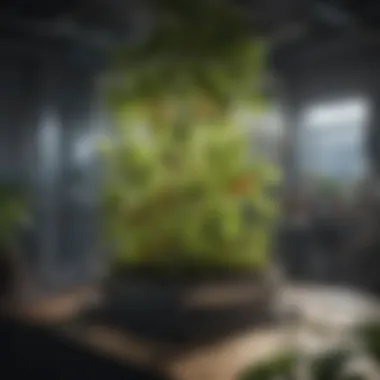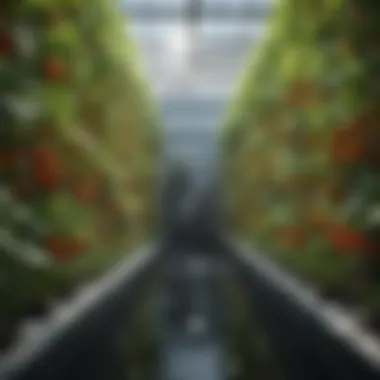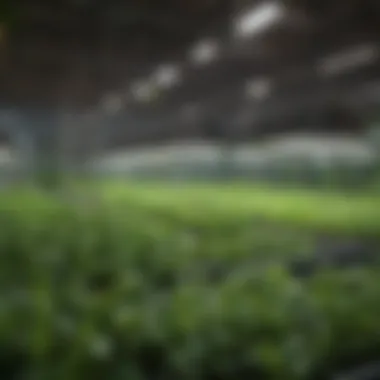Understanding Hydroponic Gardens: A Comprehensive Guide


Intro
Hydroponic gardening is gaining attention as a modern agricultural technique that offers a viable solution to some of the limitations of traditional soil farming. By utilizing nutrient-rich water solutions, this method enables plants to grow without the need for soil. This shift in farming practices aligns well with current trends that focus on sustainability and efficiency in food production. The relevance of hydroponics is increasing, especially in urban settings where space is limited, and food transportation needs to be minimized.
The principles of hydroponics are straightforward yet effective. Nutrients are delivered directly to the plant's roots, allowing for optimal growth conditions and minimizing resource waste. Despite its advantages, hydroponic gardening poses certain challenges, which are essential for prospective gardeners and agricultural professionals to understand. This article aims to delve into the intricacies of hydroponics, from its key techniques and innovations to practical applications that pave the way for efficient gardening.
Defining Hydroponics
Understanding the definition of hydroponics is fundamental for grasping its relevance in modern agriculture. Hydroponics refers to a method of growing plants without soil, using nutrient-rich water solutions. This technique allows for precise control over nutrient delivery, which can lead to improved plant health and growth. As urban areas expand and arable land becomes scarce, hydroponics presents a viable alternative for sustainable food production.
What Constitutes Hydroponics
Hydroponics is characterized by the absence of soil in the growing process. Instead, it employs various growing mediums such as perlite, coconut coir, or rock wool that support plant roots while delivering necessary nutrients through water. The core component here is the nutrient solution - a mixture that supplies plants with essential minerals and elements, including nitrogen, phosphorus, potassium, calcium, and magnesium.
This method not only fosters plant growth but also enhances resource efficiency. Plants grown hydroponically often utilize less water than those grown in the ground. This efficiency can be crucial in areas with limited water resources. Furthermore, the ability to grow plants indoors or in controlled environments makes hydroponics an attractive choice for year-round cultivation.
Historical Background
The concept of hydroponics is not a novel one; in fact, it has historical roots dating back thousands of years. Ancient civilizations, such as the Babylonians and the Aztecs, practiced soil-less cultivation techniques. The Babylonian Hanging Gardens, often cited as one of the Seven Wonders of the Ancient World, may have utilized hydroponic principles to grow their lush plants.
In the 20th century, significant advancements in hydroponics took place. Researchers began to understand plant nutrient requirements better, leading to the development of more sophisticated hydroponic systems. In the 1930s, the term "hydroponics" was formally introduced by Dr. William Frederick Gericke, who demonstrated that plants could grow in nutrient solutions without soil. This period marked the beginning of modern hydroponic gardening, which has since evolved into a popular method among agricultural experts and enthusiasts.
"Hydroponics has the potential to address many issues related to traditional agriculture, including space limitations and resource constraints."
In summary, understanding hydroponics involves recognizing its definition, its foundational components, and its historical significance. This knowledge sets the stage for exploring the principles, types, advantages, and challenges associated with hydroponic gardening.
Principles of Hydroponic Gardening
Hydroponic gardening challenges traditional agriculture by eliminating soil as a growing medium. Instead, it relies on nutrient solutions and precise environmental controls to optimize plant growth. Understanding the principles of hydroponic gardening is essential for achieving success in this innovative farming method. Each principle plays an integral role in ensuring that plants receive what they need to thrive.
Nutrient Solutions
Nutrient solutions are the lifeblood of hydroponic systems. In soil-based agriculture, plants derive nutrients from the soil, which can be variable and often depleted after many years. Hydroponics allows for more control over nutrient delivery, making it a critical aspect of the growing process.
Nutrients can be categorized into macronutrients and micronutrients. Macronutrients are needed in larger amounts and include nitrogen, phosphorus, and potassium. Micronutrients, such as iron and magnesium, are required in smaller quantities but are equally crucial for plant health.
An effective nutrient solution closely matches the plant's needs at different growth stages. Many growers use premixed solutions, but formulating one tailored to specific crops can yield better results. It's important to monitor and adjust the nutrient concentration, as both deficiencies and excesses can harm plant growth.
Water Quality Management
Water quality is another fundamental principle that impacts hydroponic gardening. Unlike traditional methods where soil may buffer water quality, hydroponic systems directly depend on the water's properties. The quality of water affects nutrient availability and can influence plant health.
Key factors include pH level and electrical conductivity.
- pH Level: This measures the acidity or alkalinity of the water. Most crops thrive within a specific pH range, typically between 5.5 and 6.5. If the water pH strays too far from this range, nutrient uptake can be impaired.
- Electrical Conductivity (EC): This is a measure of the solution's ability to conduct electricity and is an indirect indicator of nutrient concentration. A high EC can mean over-fertilization, while low EC signals nutrient deficiencies.
Regular monitoring of water quality is essential for the success of a hydroponic garden. Adjustments to the nutrient solution and water may be necessary based on these readings, ensuring an optimal growing environment.
Light Requirements
Light is a critical factor in hydroponic gardening, influencing photosynthesis and plant health. Without adequate light, even the best nutrient solutions and water quality can lead to poor growth outcomes. Plants have different light requirements, which vary based on their type and growth stage.
In indoor hydroponic systems, grow lights are often used to simulate sunlight. Key considerations include the type of light source, duration, and intensity:
- Type of Light: Common options are LED and fluorescent lights. LEDs are energy-efficient and can be tuned to emit specific wavelengths beneficial for plant growth.
- Light Duration: Most plants need around 12 to 16 hours of light each day for optimal growth. This can be adjusted based on the plant species and growth phase.
- Light Intensity: This refers to the brightness of the light. Insufficient light can lead to leggy plants, while excessive light can cause other issues like leaf burn.
A solid understanding of these light requirements allows growers to create optimal growing conditions, boosting yields and plant health.
"Hydroponic gardening is founded on a handful of principles. Mastering these fundamentals paves the way for successful growth and greater yields."
By grasping the principles of hydroponic gardening, farmers and gardening enthusiasts can implement techniques that enhance productivity while managing resources efficiently.


Types of Hydroponic Systems
Understanding the different types of hydroponic systems is essential for anyone looking to venture into soil-less gardening. Each system offers distinct advantages, and the choice often depends on factors such as available space, initial investment, and the types of crops intended for cultivation. Selecting the optimal hydroponic system can significantly enhance both plant growth and overall productivity.
Nutrient Film Technique (NFT)
The Nutrient Film Technique, or NFT, is a highly efficient hydroponic method that involves a thin film of nutrient-rich water flowing over the roots of plants. This technique promotes quick absorption of nutrients while ensuring that the roots remain aerated. NFT systems are often set up using sloped channels or troughs, where the nutrient solution is recirculated.
Benefits of NFT include:
- High efficiency: Nutrient solutions are recycled, minimizing waste.
- Reduced water usage: As only a fraction of the water is needed, this method is surprisingly water-efficient.
However, NFT systems require consistent monitoring to avoid the risk of pump failure. If it occurs, plant roots could dry out quickly, leading to potential loss.
Deep Water Culture (DWC)
In Deep Water Culture, the plants are suspended in a nutrient solution, with their roots submerged in water. An air pump continuously oxygenates the water, ensuring that the plants receive sufficient oxygen. DWC systems are often easy to set up and can lead to accelerated growth rates.
Key points about DWC include:
- Simplicity in design: Fewer moving parts mean lower risk of system failure.
- Faster growth: The constant supply of oxygen and nutrients promotes rapid plant growth.
An important consideration is that DWC systems can struggle with temperature control, as warmer water holds less oxygen. Close attention to the temperature is necessary to maintain optimal conditions.
Aeroponics and Mist Systems
Aeroponic systems suspend plants in the air and regularly mist the roots with nutrient-rich water. This approach results in excellent oxygenation and nutrient uptake. The system’s design allows for high-density plant arrangements, making it ideal for small spaces.
Advantages of aeroponics:
- Maximized growth potential: High efficiency in nutrient absorption leads to faster growth compared to other systems.
- Less water usage: Mist systems can drastically reduce water consumption.
However, it can be quite technical to manage correctly. Any failure in the misting system can lead to plants drying out swiftly.
Ebb and Flow Systems
Ebb and Flow systems, also known as flood and drain systems, periodically flood the plant roots with nutrient solution and then drain it back into a reservoir. This cycle allows for nutrient absorption while providing necessary oxygen when the roots are exposed between floodings.
Highlights of Ebb and Flow systems include:
- Versatility: They can accommodate a variety of plant types and sizes.
- Simplicity of maintenance: Regular checks can ensure the system operates effectively without high-tech solutions.
On the downside, the water quality must be monitored constantly to prevent algae or bacteria from developing in stagnant water during drainage.
Wicking Systems
Wicking systems utilize a wick, often made of cotton or another absorbent material, to draw nutrient solution from a reservoir to the plants. This method is straightforward and low-maintenance, making it suitable for beginners.
Notable features of wicking systems include:
- User-friendly: Easy setup and operation, ideal for novice gardeners.
- Low-cost: Minimal equipment is required, reducing initial setup costs.
Despite its many advantages, this system may not deliver enough nutrients for larger or fast-growing plants, making it less effective for high-demand crops.
In choosing the right hydroponic system, understanding the specific needs of the target plants and the gardener’s capabilities is crucial for success.
Advantages of Hydroponic Gardening
Hydroponic gardening presents several advantages that make it a compelling choice for both amateur and seasoned gardeners. This section delves into the significance and specific benefits associated with hydroponic systems. Understanding these advantages is crucial for individuals considering alternative gardening methods or aiming to maximize their yield and efficiency.
Space Efficiency
One of the most notable benefits of hydroponic gardening is its space efficiency. In traditional soil gardening, plants require extensive space to grow due to the need for soil arrangements. Hydroponics eliminates this requirement, allowing plants to be stacked vertically or placed closely together. This compact structure is especially beneficial for urban areas where gardening space is limited. Hydroponic systems can be set up indoors or on rooftops, further capitalizing on residential and urban landscapes. Consequently, gardeners can cultivate a larger quantity of crops in smaller spaces.


Water Conservation
Water conservation is another significant advantage of hydroponic gardening. In conventional farming, excessive water usage often leads to wastage. Hydroponics minimizes this issue through recirculation techniques. Water is delivered to the plants via a closed system, which reduces runoff and evaporation. Studies suggest that hydroponic systems can use up to 90% less water compared to traditional soil gardening. This conservation aspect is particularly crucial in arid regions or areas facing water scarcity. Additionally, water quality can be meticulously managed, ensuring that plants receive the right nutrients without contaminating groundwater sources.
Faster Growth Rates
Plants grown in hydroponic systems often exhibit faster growth rates compared to their soil-based counterparts. This is largely due to the direct delivery of nutrients and oxygen to the plant roots. As a result, plants can absorb these essential elements more efficiently. Some studies indicate that growth rates can increase by up to 30% in hydroponic setups. Such rapid growth not only enhances productivity but also allows for multiple planting cycles within a year. This is advantageous for farmers and hobbyists alike who aim to optimize their crop yields and reduce waiting times for harvest.
Less Pest Infestation
Finally, hydroponic gardening significantly réduces the risk of pest infestations. Soil-based gardening often attracts various pests and insect populations that can damage crops. In a hydroponic environment, the absence of soil disrupts typical pest life cycles. Moreover, the controlled environment of a hydroponic system makes it easier to monitor and manage threats. This leads to a lower need for pesticides and chemical treatments. As a result, crops grown hydroponically tend to be healthier and cleaner, appealing to consumers concerned about food safety and chemical exposure.
Hydroponic gardening not only enhances productivity but also promotes a sustainable approach to agriculture. This method underscores the potential for efficient resource use while meeting growing food demands.
In summary, the advantages of space efficiency, water conservation, faster growth rates, and reduced pest infestation collectively make hydroponic gardening an attractive alternative. These benefits provide compelling reasons for farmers and gardening enthusiasts to explore hydroponics as a viable option for modern agriculture.
Challenges and Considerations
In the realm of hydroponic gardening, it is essential to acknowledge various challenges and considerations that aspiring gardeners may face. Understanding these factors is crucial for successful implementation and long-term viability. Hydroponics can present unique hurdles, including financial investment, technical knowledge, and management of pests and diseases.
Initial Setup Costs
One of the significant factors that affect the accessibility of hydroponic gardens is the initial setup cost. These expenses can significantly differ based on the chosen system type, scale of the project, and specific components needed.
Typical costs may include:
- Equipment: This encompasses pumps, nutrient delivery systems, containers, and grow lights. Depending on quality and technology, prices can fluctuate.
- Materials: Nutrient solutions, substrates like rock wool or clay pellets, and pH testing kits are essential for starting a hydroponic garden.
- Space Preparation: Modifying an existing space may involve expenses associated with ventilation, heating, and other infrastructure elements.
While these initial investments might seem daunting, they often translate into long-term savings in water and crop yield. It's crucial to analyze potential returns on investment.
Technical Knowledge Requirements
Successfully managing a hydroponic garden necessitates a solid foundation of technical knowledge. This aspect encompasses various domains, including botany, chemistry, and engineering concepts. Having a clear understanding of how different systems operate is vital.
Some critical areas of knowledge include:
- Nutrient Solutions: Familiarity with nutrient composition and how to adjust them based on crop requirements is essential.
- Water Quality: Knowing the importance of pH balance and electrical conductivity can help optimize plant growth.
- Environmental Control: Understanding factors like light intensity and temperature can influence plant health.
Gardeners may consider attending workshops or online courses to improve technical skills and ensure their systems run smoothly.
Pest and Disease Management
Despite the advantages of hydroponics, pests and diseases can still pose significant risks. Proper management strategies are vital to maintaining a healthy garden. Implementing preventive measures can ensure your plants thrive in a controlled environment.
Some effective management strategies include:
- Regular Inspections: Frequent checks for signs of pests or diseases can help catch problems early.
- Cleanliness: Keeping the garden area clean and tidy can deter pests and reduce disease spread.
- Biological Controls: Introducing beneficial insects or using organic solutions can maintain a balanced ecosystem within the garden.
Effective management practices require ongoing attention and knowledge. By being proactive, gardeners can mitigate potential issues and protect their plants.
"Understanding the challenges of hydroponic gardening can transform obstacles into opportunities for growth and improvement."
Establishing a Hydroponic Garden
Establishing a hydroponic garden is a fundamental step for anyone interested in this innovative method of growing plants. A well-planned hydroponic garden allows for efficient production, optimizing plant growth while minimizing the use of resources. Hydroponics eliminates the need for soil, making it an attractive option for urban gardeners or those with limited space. The balance and attention given to the setup directly influence plant health and yield.
Planning Your Garden Layout
Planning the layout of your hydroponic garden is crucial for maximizing its efficiency. Consider the available space and ensure there is adequate room for all components including plants, reservoir tanks, and lighting. A well-organized layout facilitates easy access to plants for maintenance and harvest.
- Vertical Gardening: If space is limited, vertical gardening can be useful. Utilizing towers or shelves can allow for a greater number of plants than traditional horizontal layouts.
- Accessibility: Ensure paths between rows or plants are wide enough for you to comfortably navigate and work within the garden.
- Light Sources: Positioning plants closer to the light source, whether natural or artificial, is helpful. This may involve adjusting the height of growing systems.


Choosing the Right System
Selecting the right hydroponic system is essential. There are various systems available, each with unique features and advantages. The choice should depend on your space, budget, and specific goals for the garden. Popular systems include:
- Nutrient Film Technique (NFT): This method involves a thin film of nutrient solution flowing over the roots, providing a constant supply of nutrients.
- Deep Water Culture (DWC): DWC systems allow roots to be submerged in oxygenated nutrient solution, which can lead to excellent growth rates.
- Ebb and Flow Systems: These systems periodically flood the growing area, followed by draining, providing a balance of moisture and aeration.
Evaluate each system's start-up costs, maintenance needs, and crop suitability to determine what works best for your situation.
Selecting Suitable Crops
Choosing the right crops for your hydroponic garden can significantly impact success. Not all plants grow well in hydroponic systems, so it is important to select wisely. Some crops that thrive in hydroponic conditions include:
- Lettuce: Rapid growth and shallow roots make lettuce an ideal choice.
- Herbs: Basil, mint, and cilantro adapt well to hydroponics and have short growth cycles.
- Tomatoes: With proper support, tomatoes can flourish in hydroponic systems, providing high yields.
It is beneficial to consider crop rotation and compatibility with your systems. Intercropping can maximize production while maintaining soil health, even in soil-less environments.
By thoroughly planning your garden layout, choosing the appropriate hydroponic system, and selecting the right crops, you establish a solid foundation for a successful hydroponic garden. This groundwork sets forth a sustainable venture into the world of soil-free gardening.
Maintaining Your Hydroponic Garden
Maintaining your hydroponic garden is fundamental for ensuring healthy plant growth and maximizing yields. Unlike traditional soil-based gardening, hydroponics requires a precise balance of nutrients and water, along with regular monitoring of environmental conditions. A well-maintained hydroponic system not only promotes plant health but also saves resources like water and nutrients, which can lead to more sustainable practices.
Monitoring Nutrient Levels
Monitoring nutrient levels is a critical aspect of maintaining a hydroponic garden. Plants require specific nutrients in precise quantities, which must be delivered through the nutrient solution. This solution must be tested regularly to ensure that the pH and electrical conductivity (EC) are within optimal ranges.
- Regular Testing: Use a pH meter and an EC meter to check nutrient levels. Adjust the solution as needed to provide balanced nutrition, preventing deficiencies or toxicities.
- Signs of Imbalance: Yellowing leaves, stunted growth, or brown spots can indicate nutrient deficiencies. Recognizing these signs early can help you adjust the solution effectively.
- Nutrient Solutions: Depending on the crops you are growing, the nutrient solution may need to be modified. For example, leafy greens might require different nutrients compared to fruiting plants like tomatoes.
Water Maintenance Practices
Water quality is vital for the success of a hydroponic garden. Maintaining water quality involves ensuring it is clean and free from pathogens while also containing the necessary nutrients.
- Water Quality Tests: Test your water source regularly for contaminants and adjust your nutrient solution accordingly. Using filtered or distilled water can prevent unwanted chemicals from affecting your plants.
- Changing Water: Depending on the system, it may be necessary to change the water every two weeks or so. This practice reduces the risk of disease and helps replenish nutrients consumed by the plants.
- Temperature Control: The temperature of the water can affect nutrient availability. Keep the water temperature within an optimal range for plant growth, generally between 18-22 degrees Celsius.
Regular System Checks
Conducting regular checks on your hydroponic system is essential to prevent and address any issues before they escalate.
- Inspect System Components: Check pumps, hoses, and other equipment for any signs of wear or blockages. Ensure that they are functioning correctly to provide adequate water and nutrients.
- Monitor Environmental Conditions: Keep an eye on temperature and humidity levels. These factors influence plant growth and can help you identify and adjust any potential problems.
- Preventive Maintenance: Cleaning the system and sterilizing components can help reduce the risk of disease and promote a healthier environment for your plants.
"An ounce of prevention is worth a pound of cure."
Future Trends in Hydroponic Gardening
The future of hydroponic gardening is particularly relevant in today's agricultural landscape, marked by the need for increased food production, urbanization, and environmental challenges. As global populations rise and arable land decreases, innovative approaches to agriculture will be essential. Hydroponics offers a solution, allowing crops to be grown in controlled environments with limited resources. This section discusses the significant trends shaping the future of hydroponic gardening, focusing on technological advancements and sustainability considerations.
Technological Advancements
Recent years have seen remarkable technological progress in hydroponic systems. Automation plays a crucial role in streamlining processes, which can ultimately lead to better yields and lower labor costs. With the rise of smart technology, growers can monitor systems remotely. Sensors detect nutrient levels, pH, and moisture content, ensuring optimal conditions for plant growth. These advancements diminsh human error and precise adjustments can be made in real time.
Another area of growth is the use of artificial intelligence. Machine learning algorithms can analyze data from hydroponic systems and suggest improvements. Data-driven decision making enhances productivity and resource allocation.
- Vertical Farming: Urban spaces are adopting vertical farming, utilizing walls and other vertical structures for hydroponic systems. This trend caters to local markets and reduces transportation emissions.
- LED Lighting: Energy-efficient LED lights are evolving, allowing growers to simulate optimal sunlight conditions. Tailoring light spectra to specific crop needs can enhance growth rates significantly.
These technologies represent just a portion of the innovations on the horizon. As systems become more efficient, they also become more accessible for hobbyists and commercial growers alike.
Sustainability Considerations
Sustainability is an increasingly important focus in hydroponic gardening. As environmental issues grow more pressing, consumers are demanding sustainable practices from the agricultural sector. Hydroponics, by design, uses less water compared to traditional agriculture. Closed-loop systems recycle nearly 90% of water, which conserves this vital resource.
Furthermore, hydroponic gardens can be established in urban areas, reducing the carbon footprint associated with food transportation. This supports local food systems and provides fresh produce to communities.
Key sustainability aspects include:
- Resource Efficiency: Hydroponic systems can use renewable energy sources, like solar power, to operate.
- Reduced Pesticide Use: Growing plants in controlled conditions can lead to fewer pest problems, reducing the need for chemical pesticides.
- Waste Reduction: Hydroponics can transform food waste into compost for local gardens, promoting a circular economy.
As the field of hydroponics evolves, addressing sustainability will be paramount. The interplay between technology and sustainable practices will shape a resilient agricultural future, ensuring that the needs of both consumers and the environment are met.
> Future trends in hydroponic gardening emphasize not only technological innovation but also the necessity for sustainable practices, pushing the industry towards a greener and more efficient future.



